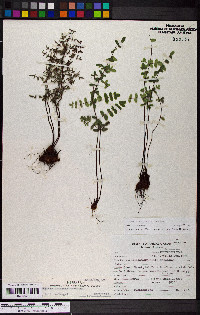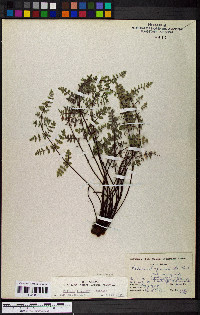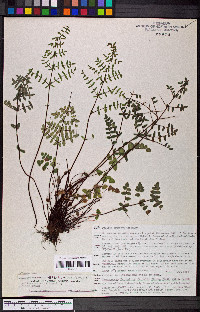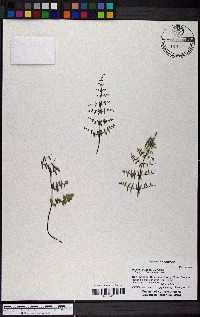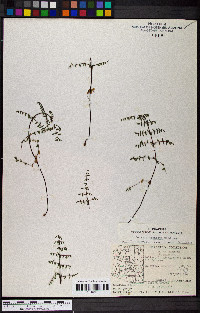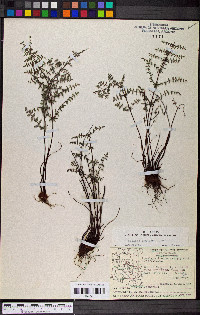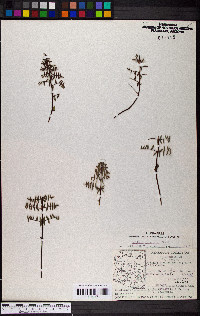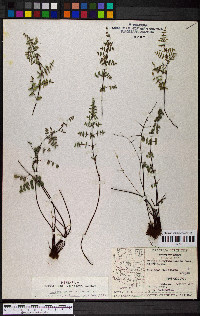Pellaea truncata
|
|
|
|
Family: Pteridaceae
Spiny Cliffbrake, more...cliff brake, Spiny Cliff Brake (es: helecho)
[Pellaea longimucronata auct. non Hook.] |
Stems compact, ascending, stout, 5--10 mm diam.; scales bicolored, linear-subulate, 0.1--0.3 mm wide, centers black, thick, margins brown, thin, erose-dentate. Leaves somewhat dimorphic, sterile leaves shorter and less divided than fertile leaves, clustered on stems, 8--40 cm; croziers sparsely villous. Petiole dark brown, lustrous, flattened or slightly grooved adaxially, without prominent articulation lines. Blade ovate-deltate, usually 2-pinnate proximally, 4--18 cm wide; rachis brown throughout, straight, shallowly grooved adaxially, usually glabrous. Pinnae perpendicular to rachis to slightly ascending, not decurrent on rachis, usually with 9--25 ultimate segments; costae straight, 20--70 mm, much longer than fertile ultimate segments. Ultimate segments narrowly oblong, 4--10 mm, leathery, glabrous; margins recurved on fertile segments, usually covering less than 1/2 abaxial surface, borders whitish, nearly entire; apex mucronate. Veins of ultimate segments obscure. Sporangia long-stalked, containing 64 spores, intermixed with abundant farina-producing glands. 2 n = 58. Sporulating late spring--fall. Cliffs and rocky slopes, on various substrates but rarely observed on limestone; 600--2500 m; Ariz., Calif., Colo., Nev., N.Mex., Tex., Utah; n Mexico. Most manuals refer to Pellaea truncata as P . longimucronata , a name shown to be invalid by A. Cronquist et al. (1972+, vol. 1). Populations located near the range of P . mucronata in the Mojave Desert are often difficult to identify because of the subtlety of the characters involved and an apparent tendency to produce sterile (and possibly fertile) hybrids. Morphologically intermediate hybrids between P . truncata and P . wrightiana are common in regions where the ranges of the two species overlap, but these are easily identified by their malformed spores.
General: Compact ascending stems, 5-10 mm in diameter; scales bicolored, linear-subulate, 0.1-0.3 mm wide, black centers, thick, brown margins, thin, erose-dentate. Leaves: Somewhat dimorphic, sterile leaves shorter and less divided than fertile leaves, clustered on stems, 8-40 cm; young growth sparsely villous; petiole dark brown, lustrous, flattened or slightly grooved above, without prominent articulation lines; blade ovate-deltate, 2-pinnate near end, 4-18 cm wide, pale green, rachis brown throughout, straight, shallowly grooved above, glabrous; pinnae perpendicular to rachis, to slightly ascending, usually with 9-25 ultimate segments, narrowly oblong, 4-10 mm, leathery, glabrous, margins recurved, nearly entire with a mucronate apex. Sporangia: Long-stalked, containing 64 spores intermixed with abundant flour-producing glands, sori obscured and dull brownish. Ecology: Found on cliffs and among rocks from 2,000-8,000 ft (610-2438 m); sporulating late spring to fall. Notes: Rarely observed on limestone, but found on a variety of other substrates. There is a possibility of P. wrightiana hybidizing with this species, but P. wrightiana has a range only down to 4,000 ft (1219 m). Etymology: Pellaea is from the Greek pellaios, dark, alluding to the stalk, while truncata means abruptly cut off. Sources: FNA 1993, Wiggins 1964, Kearney and Peebles 1969 FNA 1993, Wiggins 1964, Kearney and Peebles 1969 Common Name: spiny cliffbrake Rarity: None General: Compact ascending stems, 5-10 mm in diameter; scales bicolored, linear-subulate, 0.1-0.3 mm wide, black centers, thick, brown margins, thin, erose-dentate. Leaves: Somewhat dimorphic, sterile leaves shorter and less divided than fertile leaves, clustered on stems, 8-40 cm; young growth sparsely villous; petiole dark brown, lustrous, flattened or slightly grooved above, without prominent articulation lines; blade ovate-deltate, 2-pinnate near end, 4-18 cm wide, pale green, rachis brown throughout, straight, shallowly grooved above, glabrous; pinnae perpendicular to rachis, to slightly ascending, usually with 9-25 ultimate segments, narrowly oblong, 4-10 mm, leathery, glabrous, margins recurved, nearly entire with a mucronate apex. Sporangia: Long-stalked, containing 64 spores intermixed with abundant flour-producing glands, sori obscured and dull brownish. Ecology: Found on cliffs and among rocks from 2,000-8,000 ft (610-2438 m); sporulating late spring to fall. Notes: Distinguished by the dark, shiny petioles and rachises; the bicolored stem (at the base) scales with a black center and brown margins; and the 2-3 times pinnate leaves with the largest pinnae with 11 or more segments. Rarely observed on limestone, but found on a variety of other substrates. There is a possibility of P. wrightiana hybidizing with this species, but P. wrightiana has a range only down to 4,000 ft (1219 m). Ethnobotany: Unknown Etymology: Pellaea is from the Greek pellaios, dark, alluding to the stalk, while truncata means abruptly cut off. Synonyms: Pellaea longimucronata Editor: SBuckley 2010, FSCoburn 2015 |
|
|
|







































